Access to funding coupled with ongoing wise money management is arguably the most critical aspect of business ownership. After all, without continuous access to capital, the wheels can’t turn effectively in your business.
This is especially true in today’s financial technology innovation and digitization of assets. For instance, as customers ask if they can pay for their order with Bitcoin, it becomes increasingly clear that the landscape has changed. However, staying current with new technologies and data security is no longer in the “nice to have” category. Therefore, every business owner needs to remain sharp and well-informed.
But where should you start? The finance publications listed below are excellent places to start, but the publication that works best for you will vary depending on your industry and level of expertise. No one can keep up with everything related to finance, so pick and choose the aspects of finance that matter most to you and subscribe as appropriate.
Table of Contents
- What Makes A Good Finance Publication?
- Characteristics of a Quality Finance Publication
- Wall Street Journal
- ReadWrite
- Kiplinger Magazine-USA
- MarketWatch
- Due
- Reuters
- Financial Times
- The Street
- Bloomberg Markets
- CNN Business/Money
- Money Magazine
- CNBC
- Barron's Magazine
- Forbes
- Killer Startups
- The Economist
- Fortune
- Investopedia
A Brief Review of Each Publication:
1. Wall Street Journal: Widely acknowledged to be at the top of its game, the WSJ provides the latest news articles surrounding business and finance.
2. ReadWrite: An accessible, easy-to-read publication if you want to learn everything you need about financial technology (a.k.a. fintech, for example).
3. Kiplinger Magazine-USA: This is a great place to start if you’re looking for a trusted source for business forecasting.
4. MarketWatch: If you’re looking for business finance news, MarketWatch’s got it.
5. Due: A simple, informative, and user-friendly blog for anyone wanting to plan well for their retirement.
6. Reuters: Reuters has established itself as a reliable news source to keep you informed about news events that can impact your finances.
7. Financial Times: If you are looking for financial analysis, the Financial Times synthesizes world events and makes them understandable to a broad audience.
8. The Street: Certainly a top-notch publication for sifting through news regarding investing and other current financial events, The Street enjoys an excellent reputation for accuracy.
9. Bloomberg Markets: This is your publication if you need to stay updated about current market trends.
10. CNN Business/Money: Similarly, this publication from CNN offers actionable insights for those interested in improving their finances.
11. Money Magazine: An inspiring publication to check out, especially if you want to accomplish personal financial goals by learning how others have succeeded.
Continued
12. CNBC: If you’re looking for unique features to stay up-to-date about the financial climate worldwide, this is an excellent publication.
13. Barron’s Magazine: Barron’s is over a hundred years old and a trusted resource for seasoned investors.
14. Forbes: One of the more prominent financial publications, you can always find reliable financial information, profiles, and insights to help you succeed at Forbes.
15. Killer Startups: This is a helpful resource for entrepreneurs who want to constantly improve their finances as they launch and support newer business endeavors.
16. The Economist: The best publication to stay informed about the global financial climate.
17. Fortune: Millions trust this publication. And, it serves as an entry point for those who want to learn about a wide array of business and finance topics.
18. Investopedia: This publication is an excellent resource for investment market newcomers.
What Makes A Good Finance Publication?
To be worth the time and effort it takes to subscribe and regularly review finance publications, they should help the reader become more financially literate.
But, which publications work best can look different for everyone. Whether that’s improving your finances, starting a business, or making sure your current business's financials are correct, each publication should cater to your individual needs.
Characteristics of a Quality Finance Publication
In our opinion, a good finance publication should certainly hit all three of these marks.
1. Reliable
Finance can be a tricky subject. Therefore, you want to ensure that your publication is correct, reliable, and dependable. The last thing you need is to be led astray.
2. Current
Meanwhile, each publication should provide the most relevant information to inform readers to make the best financial decision. So, look for date stamps on articles as a starting point. Likewise, there are bonus points if the publication goes back and updates stories as they develop.
3. Easy to Use
Above all, each website should be easy for the reader to navigate. But, it should not take the reader ages to find the information they seek. In short, you are using these resources to learn about finance, not learn how to use someone else’s website through trial and error.
The Top Finance Publications Reviewed
1. Wall Street Journal
Best publication for understanding how the headlines impact the world of finance.
Widely considered one of the top publications in the world of finance, the WSJ provides the most current articles regarding business and financial news. Therefore, you can find information on the economy, stock market, and financial services.

2. ReadWrite
Great for those who need a quick overview of financial trends and tech.
This publication is a hub for everything business, tech, and financial news. So, you can check it out to find the latest fintech news to stay in the know about your financial future. Furthermore, if you’re looking for the newest information about tech-oriented finance, give ReadWrite a view.

3. Kiplinger Magazine-USA
Kiplinger is best for the individual seeking tools, tips, and finance predictions.
This publication offers its readers personal finance news as well as trusted business forecasting. Readers can also access several money management tools, calculators, infographics, etc. In addition to that, you can get advice on taxes, retirement, investing, wealth creation, and more.

4. MarketWatch
Investors who want to stay current on trends affecting stocks and investments.
MarketWatch is a top provider for everything business finance-related. For example, you can find information about business news, stock market updates, investment tools/data, and personal finance. As a result, the MarketWatch stock screener is a popular feature among readers.

5. Due
Retirement planning resource available to help people retire with financial security.
Overall, Due is a trusted resource offering daily insights on retirement, annuities, personal finances, money management, and more. Additionally, every article published there is reviewed and fact-checked by members of their Expert Review Board.

6. Reuters
Reuters enjoys a well-earned reputation for its commitment to accuracy.
This publication has certainly been a highly trusted finance publication for years. Additionally, reuters provides information about investing, business, stock market, etc. You can also find a plethora of personal financial advice. Consequently, this is an excellent publication for those who want the most accurate information from a trusted pub every time.

7. Financial Times
News related directly to finance gets its best summary and analysis here.
Financial Times produces content around financial news, data, analytics, economic news, etc. You can also find articles on financial analysis. This publication is just for finance-related news versus other publications on this list that cater to different categories, so you know finance news is their specialty.

8. The Street
A great resource for investors just starting out or well-seasoned.
This publication focuses mainly on the news related to investing, current events, and opinion pieces. Additionally, The Street also offers paid services to provide analysis of existing markets and stock recommendations typically reserved for advanced investors. As a result, this is an excellent publication for all investor types, both new and well-seasoned.

9. Bloomberg Markets
Bloomberg specializes in finance-related trends, opinion pieces, and video content.
An influential publication, Bloomberg Markets covers the latest market trends, business stories, and opinion articles. And, there’s a wide variety of material available here. You can find video content as well as current financial news.

10. CNN Business/Money
CNN Business dwarfs most competitors, with plenty of accessible finance information.
Meanwhile, as one of the larger financial news websites, CNN Business is a reader’s go-to place for information that could affect your finances. So, you can find plenty of information about tech, stocks, and financial headlines.

11. Money Magazine
Money is a terrific resource for those committed to learning more about finance.
Money’s primary goal is to educate readers to help them accomplish their personal financial goals. This includes savings, real estate, spending, investments, etc.

12. CNBC
CNBC features real-time updates, a knowledgable newsroom, and expert opinion pieces.
This publication provides business and financial news articles and is a widely popular publication. They also feature a live stream that updates coverage about financial markets in real-time. Moreover, CNBC has critical features, including a business newsroom, expert guest columns, visual stories, etc.

13. Barron’s Magazine
Barron’s serves the more-seasoned investor with stock picks, investments, and policy.
For over 100 years, Barron’s has been one of the most respected finance publications, above all. While most of the articles require readers to understand the basics of financial markets, you can find articles about personal finance, investing, economy, policy, and Barron’s stock picks.

14. Forbes
Forbes helps readers learn from other success stories as they recount finance strategy.
In the same vein, this publication is considered a top resource for financial updates and news. Additionally, on Forbes, you can always find trusted and reliable information. Moreover, Forbes regularly features entrepreneurial profiles that provide insight into tactics and strategies that have proven successful for others.

15. Killer Startups
If you have a budding entrepreneurial spirit, Killer Startups is a great place to start out.
Firstly, being targeted toward entrepreneurs, Killer Startups provides all the information you need to be financially secure, personally and professionally. Secondly, articles are targeted at entrepreneurial spirits, especially those somewhat new to startups.
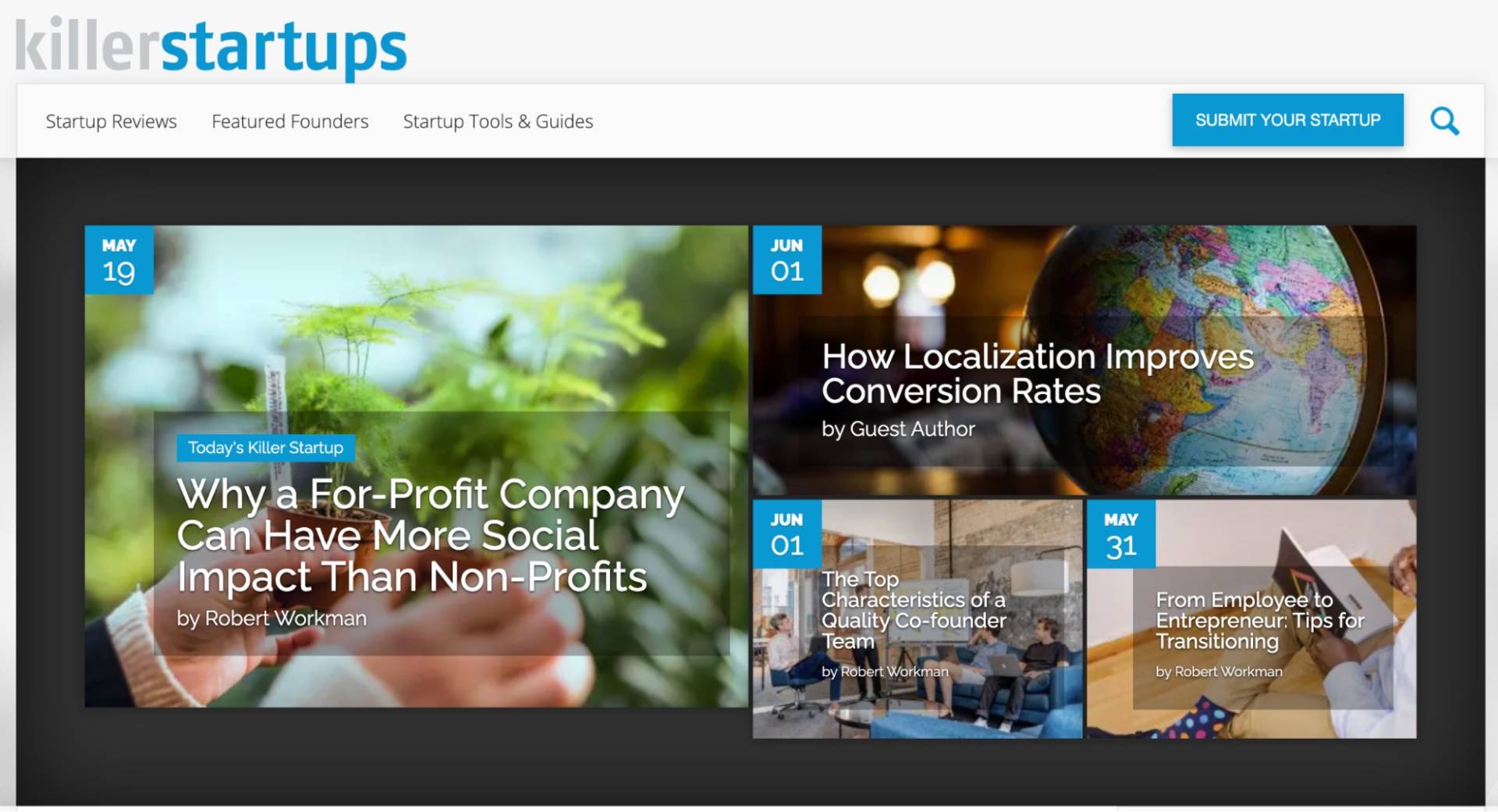
16. The Economist
With its global reach, The Economist offers insight into an increasingly intertwined world.
If you’re looking for financial news from all over the world, you’re certainly in the right place. The Economist covers economic stories from across the globe to inform its readers of the entire financial market, not just current events but also how they reverberate across world markets.
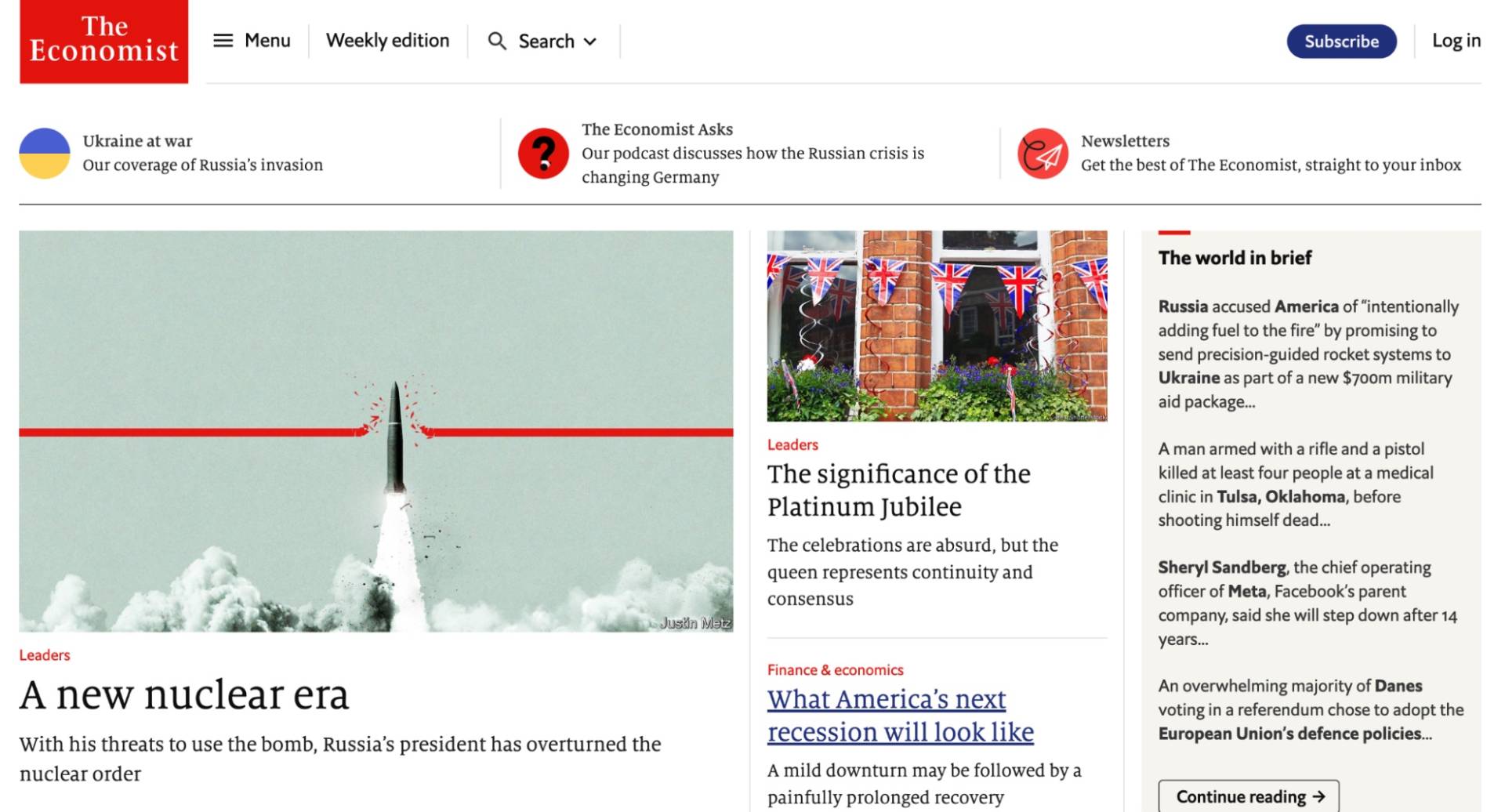
17. Fortune
Fortune offers its readers actionable insights to help them succeed financially.
Most importantly, known for its “Fortune 500” list, Fortune covers a wide range of business and finance news. Additionally, you can find a newsletter and podcast to stay informed in various ways. Fortune features both actionable insights and examples of successful business strategies.
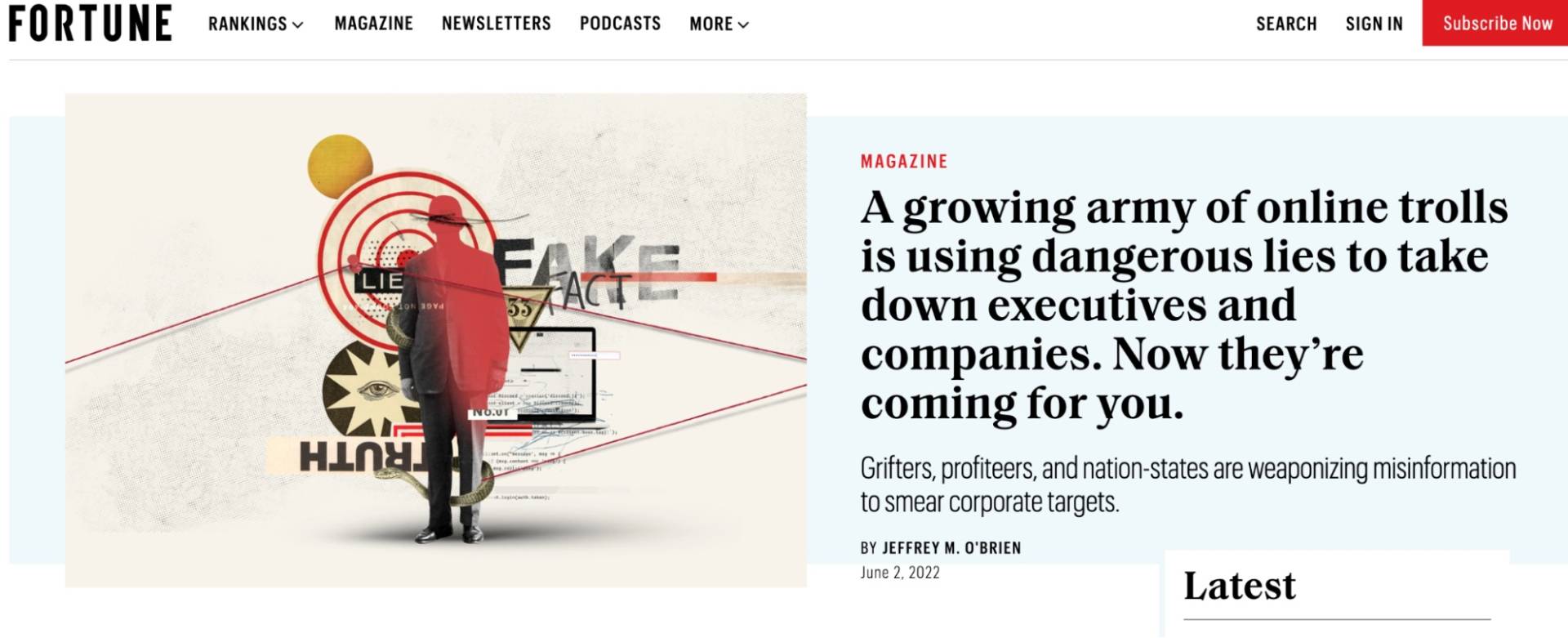
18. Investopedia
Investment can be tough for the newcomer, making Investopedia a great landing zone.
In short, Investopedia is a go-to for those looking to educate themselves on the investing market. Above all, they have an education section where newcomers can learn about the investing world, making it an excellent place for newcomers to dig in and learn.

Looking for other publication, here are a few to pay attention too:
In the wake of the past few years, it's a safe bet that your small- to medium-size business (SMB) is struggling on one or more fronts. The statistics for SMBs that shuttered their operations permanently in the first few years of this decade are sobering, to say the least. The Covid-19 pandemic is estimated to have permanently closed approximately 200,000 more businesses than had been expected. Across the past few years, roughly 600,000 companies went out of business annually.
Assuming your SMB managed to scratch its way through the office worker diaspora of 2020 and a subsequent near-total loss in foot traffic, it's likely you are looking to rebuild your business model to survive an unpredictable future. Of course, one obvious answer is to move an increasing percentage of your revenue stream into online sales. So your first instinct might be to overhaul your website and call it good.
However, launching and maintaining an SEO-friendly website — as daunting as that can be — is really only the first step.
Online marketing is hotly competitive, as anyone will tell you. Taking a "Field of Dreams" approach isn't nearly enough. You can build it, yes, but there are zero guarantees that anyone will come. Effective PR certainly includes maintaining an SEO-friendly website, but that’s just one piece in an increasingly elaborate puzzle. There's a lot more to PR than just getting a noticeable bump in your website analytics.
Finding a PR Agency That Specializes in Small Business
Competing for eyeballs online, in print, and in the local community can be intimidating for SMB owners new to search engine optimization (SEO) and other tools associated with PR. It might feel a bit like you're trying to launch a small personal aircraft using the same runway as an Airbus A380.
You can relax...that sensation of feeling ill-equipped to compete with larger companies that have deeper pockets is completely normal.
Start with the one thing your SMB brings to the table that global retailers and big-box stores can't. Namely, your local presence and the great reputation for customer service you've built up over the years. A well-rounded small business PR agency should be able to quickly discern what makes your SMB special. They will then optimize the entirety of your PR approach as a solid first step toward leveraging those advantages.
Here's what to look for when you sense you might be getting in over your comfort level.
Punchlist for a Small Business PR Agency
1. Find someone who knows the difference between advertising and PR.
If the agency you interview leaps immediately to putting together a beefed-up budget for advertising, keep looking. Far too many “experts” still, to this day, confuse improved public relations with “strategic media buys.” Yes, that’s definitely another part of the equation, but it’s not the whole enchilada, either.
Instead, a small business PR agency will know, without being told, that your ad budget is probably already stretched to its breaking point. They will want to know what, if any, ROI you received for those expenditures. They’ll be very interested in the specific data points your advertising outlets provided at the end of your campaigns. (You did ask for data-driven accountability from your media outlets, right?)
2. Look for an enthusiastic willingness to work with what you have.
Similarly, the small business PR agency won’t seek to enter your workplace and start flipping over any tables. Be wary of anyone who brings a cookie-cutter approach they’ve developed and seeks to cram what you do into their new, exciting, proprietary mold. Instead, a truly helpful PR agency will look to elevate your strengths and promote widespread awareness of what you are already doing right.
Yes, you might incur some expenditures as your company expands its outreach efforts. Examples might include new signage, the services of a graphic artist, or subscriptions to automation software packages. You might offload some routine tasks associated with chatbots, answering the phone, social media posts, and so forth. These might all be well and good, but any and all expenditures must undergird the promotion of what makes your company special.
3. You want a PR company that underpromises and over-delivers.
Be wary of over-promisers. There’s a delicate balance to be struck between lowering your expectations too far and guaranteeing you’ll knock Amazon out of first place within two years.
For example, small business PR agencies that know their stuff are well aware that the leading search algorithms change frequently. What works well online today might — or might not — work quite as well next week. And besides…your online performance isn’t the only metric a competent PR expert cares about.
Depending on the niche your company occupies, online performance might not even be the most important metric! Of course, you will want to make sure that you can put numbers to performance both before and after implementing recommended changes, but these might include rate of turnover, on-site foot traffic, events hosted, suppliers added or subtracted, and so forth.
4. Ask your PR prospects to share their understanding of the value of relationships.
Your small business is situated within a community. This is true even if you are working out of your basement with no local office space or retail square footage to speak of.
What investments, if any, are you making in its wellbeing? Does your small business enjoy a favorable reputation with other local business leaders, municipalities, and city officials? Sure, your sales and payroll are contributing to the state, federal, and local tax base, but would anyone care if you suddenly uprooted everything and moved to another community?
One of the most recognizable features of a small business PR agency who knows their stuff is asking for your list of local media outlets, yes, but also opening your eyes to other relationship opportunities you may have missed. The PR agency you want to work with will ask about things such as the number of speaking engagements your team has accepted, who you are connected with via the local Chamber of Commerce, whether your suppliers truly enjoy working with you, and so on.
5. Remain open to out-of-the-box thinking and solutions.
Anyone can open up a web browser and come up with a few new ideas about public relations for the small- to medium-sized business owner. Such an approach might indeed prove fruitful — there’s nothing at all wrong with you conducting some regular research.
However, for PR pros this sort of approach is lazy and lacks imagination. Additionally, it does nothing for providing recommendations that are specifically and intentionally fashioned for your small business.
PR agencies who know what they are doing, on the other hand, take a more methodical approach. They will be slow to formulate their recommendations tailored to your actual needs. They will want to spend more time on the front end asking a lot of questions.
Yes, it’s 100% fair for an SMB owner to ask for a best-guess delivery timeline in the context of an initial meeting. After all, if a consultant spouts off several ideas you can find using Google, why are you thinking of hiring them?
6. A focus on long-term reputation management.
Hustlers tend to show up as “the new sheriff in town” and make extravagant promises. PR professionals tend to show up and provide information about your specific niche, its penetration in the local and online marketplace, and some relevant case studies they use as background information for your initial conversation.
They bring all this and more to the table before you’ve even agreed to cut a check. PR pros aren’t playing for a temporary boost in your sales. That’s fine, as far as it goes, but it’s insufficient.
The PR shop you want to bring into your stable is playing the game for keeps. They want your SMB to thrive this year, yes, but they also want you to still be in business five, 10, and 25 years from now. They know this will only happen when they help you begin moving toward an ever-improving reputation.
Suppose your business does not enjoy a good reputation for customer service, quality products or services at fair prices, and commitment to causes other than the bottom line. In that case, they will fearlessly share that insight. They will also show you what it might look like to reclaim that turf.
Effective PR? Optimize Everything You’re Already Doing Right!
For most SMB owners, public relations is not what motivated the founding of a new company. Any PR efforts should not in any way detract or distract from keeping the main thing the main thing. You want to commit your products and services to continuous improvement, so effective PR is merely that which takes what’s already true about you and makes more people aware of it.
Doubtless, your PR campaign may cause you to reexamine long-standing policies, practices, and operations. That’s OK. It’s part of the deal.
Keep a journal in whatever medium you are most likely to use at a moment’s notice. You might discover issues that need to be addressed immediately, but these are typically rare. Instead, you can expect to find areas for improvement that you can take on at your own pace.
A qualified PR agency will present ideas and options in an agenda-free manner. They will have done their job whether you accept their recommendations or not. You’ll know you’ve found the right PR professionals when you sense that they genuinely delight in your victories as much as you do.
It’s common for companies to recognize the importance of having a strong digital PR strategy. Yet, it’s also common for organizations to find themselves with big investments that yield very few results. It can also be confusing, frustrating, and hard to know who you trust.
Having an effective strategy is important, though. In a digital world, companies need to be found online. They also need to be understood for what they are and capable of managing any message about them streaming across various platforms. Like traditional public relations, it is not so much about the sales language or promotional topics. The key to success, then, is to develop an effective process of getting the message out.
Takeaway:
There are different definitions of everything that is incorporated in PR and there are clear differences between digital and traditional PR. However, most digital PR guides have the same goal of providing clear, positive information about the company or client.
Yet, digital public relations has one clear benefit over traditional methods: speed. It is possible to use these tools to get information out into the online world quickly, which empowers companies to better control the message about them. It also enables a fast pivot when circumstances warrant it. That’s much harder to do in the traditional PR world.
How to Develop Effective Digital Public Relations
A number of components make up a successful digital PR strategy. To create a strategy like this, consider the following steps.
Define Your Goals
What is the end result? What do you want to see as the result of any activity you take? It’s important to consider this carefully. In some organizations, it is about focused efforts to increase rankings in search engines. Other times, it’s to get more traffic, or targeted traffic, to a website. Still, other times, it’s to increase the brand’s identity.
Often, the more specific the goals are, the better. For example, your business needs to grow its online presence. One way to do that is by building more backlinks to your website. You may need to do more heavy lifting in brand building by networking with other websites or complementary companies to reach that goal.
Clearly Outline Your Target Audience
Who do you want to communicate to or with? If you have not yet done so, work to define personas. This should be a very specific process where you are considering who your ideal reader of any content is. Are you looking for people to sell to? If that’s the case, your content needs to focus on your end customer’s needs. Who is this customer?
Get under the skin of your brand. It’s important to do as much research as possible to find out who your customer is and what they do online. Learn what they are interacting with and what makes them buy.
Create Your Content Calendar
You know what you want to communicate and to whom. The next step is to create a calendar that allows you to create the strategy. An online calendar is a fluid tool that may change over time. However, it puts your plan into action by outlining what needs to be done and where. It also gives you a visual to use to better understand your content moving forward.
Your content calendar also provides some structure for your goals in the coming months. That is, it outlines what’s getting posted, what news releases are going out, and what things you want to celebrate.
This is especially useful for seasonal content. For example, waiting until November 1 to post information about military deals for Veterans Day could negatively impact its effectiveness. By scheduling the content in your October calendar, you can make sure it posts at the most ideal time.
Takeaway:
A good focus for PR is to consider four steps. The first is to understand and identify the goals of any campaign. Then, create plans detailed enough to drive the campaign towards its objectives.
From there, it’s necessary to execute the plans according to the goals set. The key fourth step is monitoring, analyzing, and adjusting as needed. There’s no one solution that works for all companies or campaigns.
Building Your Content
You have lots of ideas on where to go from here. The key, then, is to create content that is going to provide the message you’ve selected. Spend some time on this. Look at your audience, goals, and brand voice to create content. You need to fill up that content calendar.
A good place to start is with some interactive tools. You may want to create an infographic, for example, that provides insight into your company. Or create a tool that breaks down some of your company's more complicated data. You may want to showcase some stories about your company. Don’t be afraid to do some storytelling to paint a picture of your company’s goals.
The next consideration is for high-quality thought leadership. Most organizations need to stand out as being an expert in their industry, product, or service. Thought leadership is a big part of successful digital PR. It allows you to create articles, videos, and other content that is published with your name. It’s a great way to build your credibility. Consider providing commentary on your services. Dive deep into your industry’s innovations.
Takeaway:
If you don’t have a strategy in place, your organization has no control. Relying on the in-the-moment events does not allow your business to control messages, create positive opportunities, or pivot when needed.
A lack of strategy also means that any steps you take are likely to be underperforming and inefficient. That is what often leads to overspending on PR. Yet, taking steps now to create a plan can help make your investment go further, creating much improved results.
Publish, Analyze, and Continue to Build
The next steps are where things become busy and involved. If you are working with an agency to help you with your PR, you’ll want to rely on them for all outreach and media efforts. You will need to do some research on your own to determine where your content is going. Look at competitors for some insights.
As you begin to launch data, you’ll want to monitor what happens with it. What are the results of this move? What’s working better than other methods or content types? The more data you have, the more effective you can tweak and improve your content and outreach to achieve your goals. It’s not common to hit 100 percent right out of the door.
You’ll need to make changes over time as factors change. That also helps with building consistency. To reach your audience, you need to put information out there – in multiple forms – on a consistent basis. More so, it takes time. When you are consistent over time and invest in enough quality content, you’ll get impressive results. Without consistency, your organization may not see the results you need.
Why Invest in Digital PR?
As you consider all of these steps, it can seem overwhelming. Yet, what comes from this process is worth it. It enables you to build your brand and develop a company (and an online presence for it) that achieves your mission and goals. It also allows you to become a leader in the industry you’re in. For many organizations, this is critical for those who want to topple big brands or those that want to build long-term success.
When you think of the word tech, what comes to mind? Many of you will have different ideas of what tech looks like. The technology industry has many branches, with everything from IT, new tech gadgets, innovation, etc.
It can be hard to know where to start looking for resources when diving into the tech space. Not only must your tech publication of choice have accurate information, it also needs to suit your purposes. So if your current go-to resources aren’t keeping you up-to-date, you need to see what else is out there.
We reviewed dozens of online tech resources and found the best the web has to offer that can help with your digital PR and daily reading. Some are old standbys and some are diamonds in the rough, but all have valuable tech insight.
Table of Contents
- Top Tech Publications
- Ingredients of a Great Tech Publication
- WIRED
- ReadWrite
- Tech Crunch
- DMNews
- Forbes
- Tech Report
- Medium
- Wall Street Journal
- SmallBiz Technology
- CNET
- VentureBeat
- The Verge
- Tech Republic
- Bloomberg News
- The Next Web
- PC Magazine
Top Tech Publications:
- WIRED for tech news presented in a fun, stylish way targeted towards young professionals - Top tech publication for readers under age 40
- ReadWrite for detailed articles on subjects such as SEO, fintech, and software development - Top tech publication for e-commerce
- Tech Crunch for readers interested in a staple tech publication - Best resource for new and upcoming technology
- DMNews for data-oriented tech news - Top tech publication for data-focused topics
- Forbes for a trusted publication covering in-depth tech news - Best source of expert-written content
- Tech Report for news and reviews of the most anticipated tech releases - Best tech hardware coverage
- Medium for access to a wide range of reader-generated, tech-oriented news - Top “crowd sourced” tech publication
- WSJ for tech-related news useful for a diverse range of consumers - Top tech source for large businesses
- SmallBiz Technology for essential tech applications for small business, keeping owners informed about the tech industry - Top tech resource for small businesses
- CNET for a reliable publication to keep you updated on the latest tech trends - Best resource for mainstream tech topics
- VentureBeat is a leader in the transformative tech news space - Best coverage of innovative tech topics
- The Verge for those looking for in-depth tech pieces - Top publication for detailed tech information
- Tech Republic for IT experts in the tech space looking for detailed content - Popular tech source for IT professionals
- Bloomberg News for accessibility for beginners in the tech industry - Top publication for tech basics
- The Next Web for a wide range of topic areas that cater to every tech consumer - Best universal tech publication
- PC Magazine for reliable information on the newest tech gadgets - Best source for tech product reviews
Methodology Behind a Great Technology Publication
Creating a successful and trusted tech publication can be a tricky process. However, the publications we chose have mastered the “secret sauce” when it comes to great tech publications. Here are a few common themes we have noticed:
Easy to navigate
Each publication should be accessible for a wide range of readers. The desired information should be found with ease to make the process as efficient as possible.
Accurate
Quality publications are often backed by experts and hard facts, accompanied by credible sources.
Affordable
Many of these publications provide readers with a set number of free articles to read each month. But, if you are looking for a wider array of resources, they provide affordable monthly subscription options.
Current
A tech publication needs to do a great job of providing the most current information to its reader. This is especially important due to the constantly evolving tech landscape.
The Top Tech Publications Reviewed
1. WIRED
Top tech publication for readers under age 40
WIRED provides tech news and information in a fun, stylish way. You can find articles on topics ranging from tech gear to science, making this a great publication for young professionals. The publication is at the forefront for innovative trends and the newest technology.

2. ReadWrite
Top tech publication for e-commerce
At the forefront of tech news, ReadWrite is a go-to publication for those looking to understand the entire tech picture. Readers can find topics surrounding AI, fintech, blockchain, and more. This is a great publication to visit if you are looking for tech news in a fun, informative way.

3. TechCrunch
Best resource for new and upcoming technology
TechCrunch is a staple publication for those interested in tech news. With more than 12 million visitors per month, it is a highly trusted publication to access new technology information. They also provide unique features like a newsletter and events that can be attended by their TechCrunch+ subscribers.

4. DMNews
Top tech publication for data-focused topics
DMNews believes that a data-oriented strategy is an effective one. Here, you can find all the data-oriented tech news consumers need to be thriving employees or run a successful business. If you need a focused read that gets the point across quickly, this may be the publication for you.

5. Forbes
Best source of expert-written content
A highly respected publication, Forbes provides in-depth technical news for its readers. They provide a large contributor platform, allowing readers to gain insights from many different perspectives. You can also access a printed version that highlights some of their most successful articles. If you are a small business owner or a corporate executive, you are guaranteed to find useful information to suit your tech needs.

6. Tech Report
Best tech hardware coverage
New technology is coming out constantly and is embedded in nearly every activity. Consequently, Tech Report provides in-depth coverage of the newest technology in fields ranging from medicine to sports to manufacturing. You also have access to product comparisons and reviews, providing assistance for business and personal tech purchases.

7. Medium
Top “crowd sourced” tech publication
Medium covers a wide range of topics including data science, programming, machine learning, and more. However, it's a particularly unique publication because it allows the readers to become the writers. Therefore, anyone can write on Medium; so this makes the range of tech topics rich and diverse to allow readers to understand the entire tech picture.

8. Wall Street Journal
Top tech source for large businesses
WSJ provides readers with all the information they need to be successful business professionals. You can find in-depth articles about personal technology to make you a better consumer. Additionally, it provides valuable business tech pieces applicable to a wide array of industries.

9. SmallBiz Technology
Top tech resource for small businesses
Starting your own business can be difficult and confusing. Furthermore, many entrepreneurs are in the dark regarding the latest tech trends for your businesses success. If you’re looking for a great tool to start or grow your business, SmallBiz Technology is a great publication to have in your toolkit.
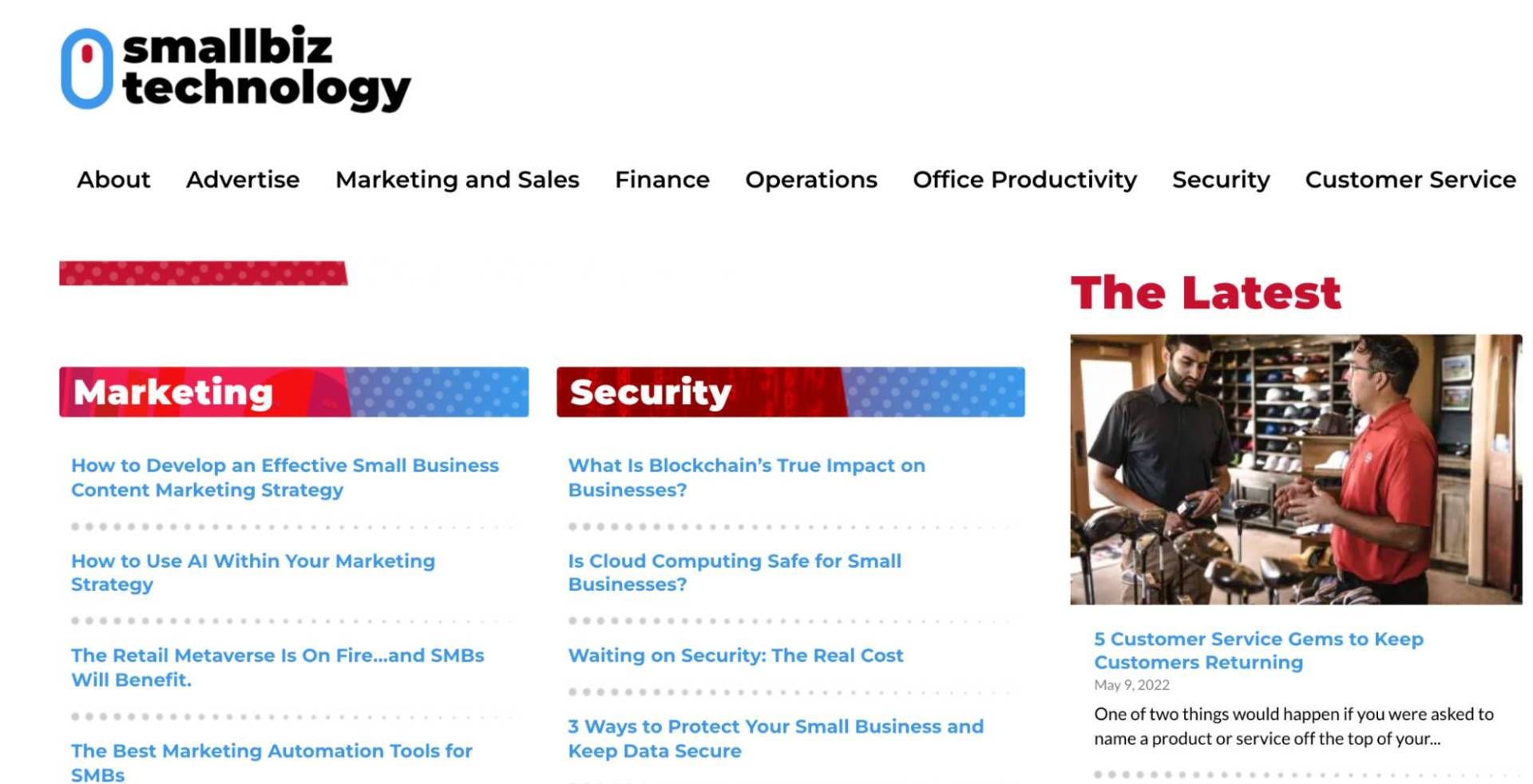
10. CNET
Best resource for mainstream tech topics
If you need to keep up with the latest tech trends and news, this is a solid, universal publication. You can find the latest information on topics such as computing, software, gaming, and more. So, this is great for those who are just starting in the tech space, but it can also be useful for long-term tech veterans.

11. VentureBeat
Best coverage of innovative tech topics
AI and machine learning can be confusing topics. However,VentureBeat guides consumers through these topics as well as many others. A leading source for transformative tech news, VentureBeat is certainly a great publication to keep on your roster.

12. The Verge
Top publication for detailed tech information
While The Verge covers topics such as entertainment and science, their pieces regarding tech are particularly valuable. For instance, you can find articles about hardware, apps, and tech companies like Apple and Google, just to name a few. In short, if you are looking for a full-circle publication on mainstream tech, this is a great resource.
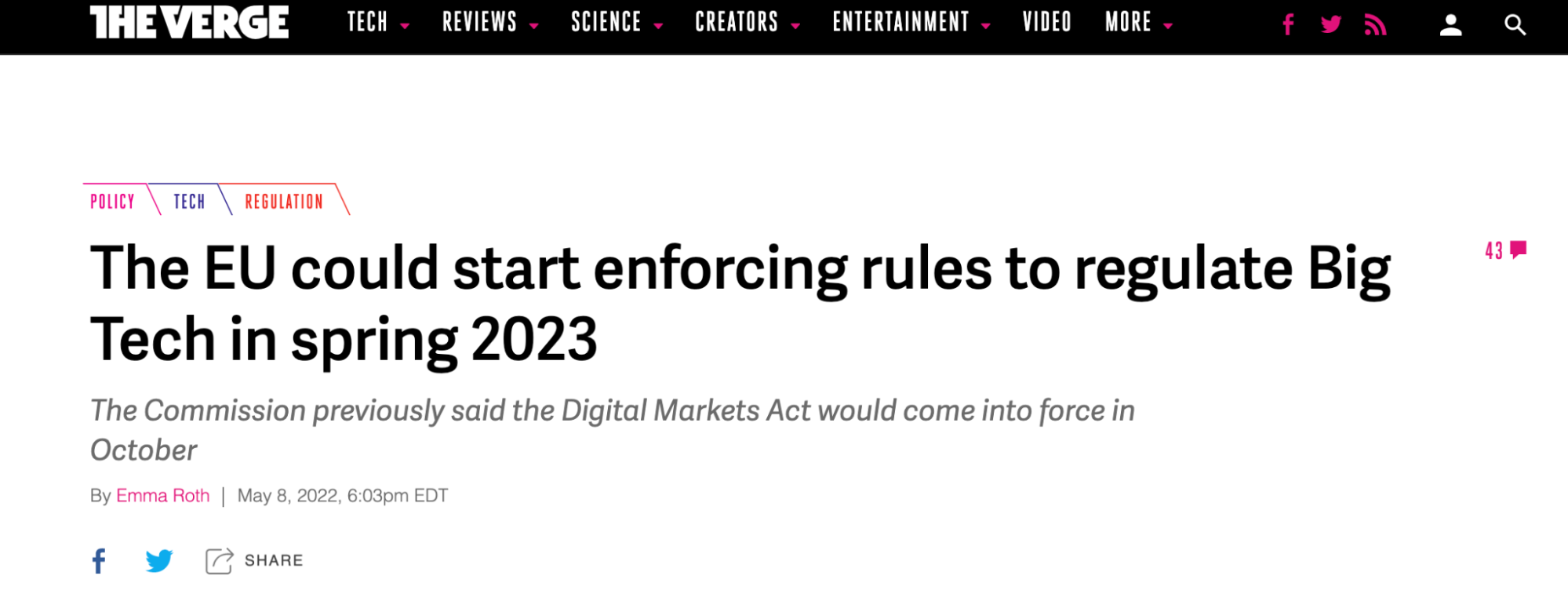
13. Tech Republic
Popular tech source for IT professionals
Tech Republic is a go-to publication for IT professionals seeking business oriented news in the IT space. In addition, they uniquely offer tech predictions to give readers an inside perspective on the evolving tech industry. Likewise, you can also find various resources including forums, a newsletter, and a resource library for readers to utilize.

14. Bloomberg News
Top publication for tech basics
A highly respected publication for everything surrounding business related news, this is a great place to start if you are a beginner in the tech industry. Moreover, you can also find many great tech tools, including Foundering, a tech oriented podcast to make learning easy and accessible. On Bloomberg News, you can find information on topics such as crypto, investments, climate adaption, and more.

15. The Next Web
Best universal tech publication
Catering to every consumer, The Next Web is a great place to check out for everything in tech-related news. For example, you can find articles on topics such as apps, AI and futurism, startups, and more. If you need to stay up-to-date on the latest tech news, check out this publication.
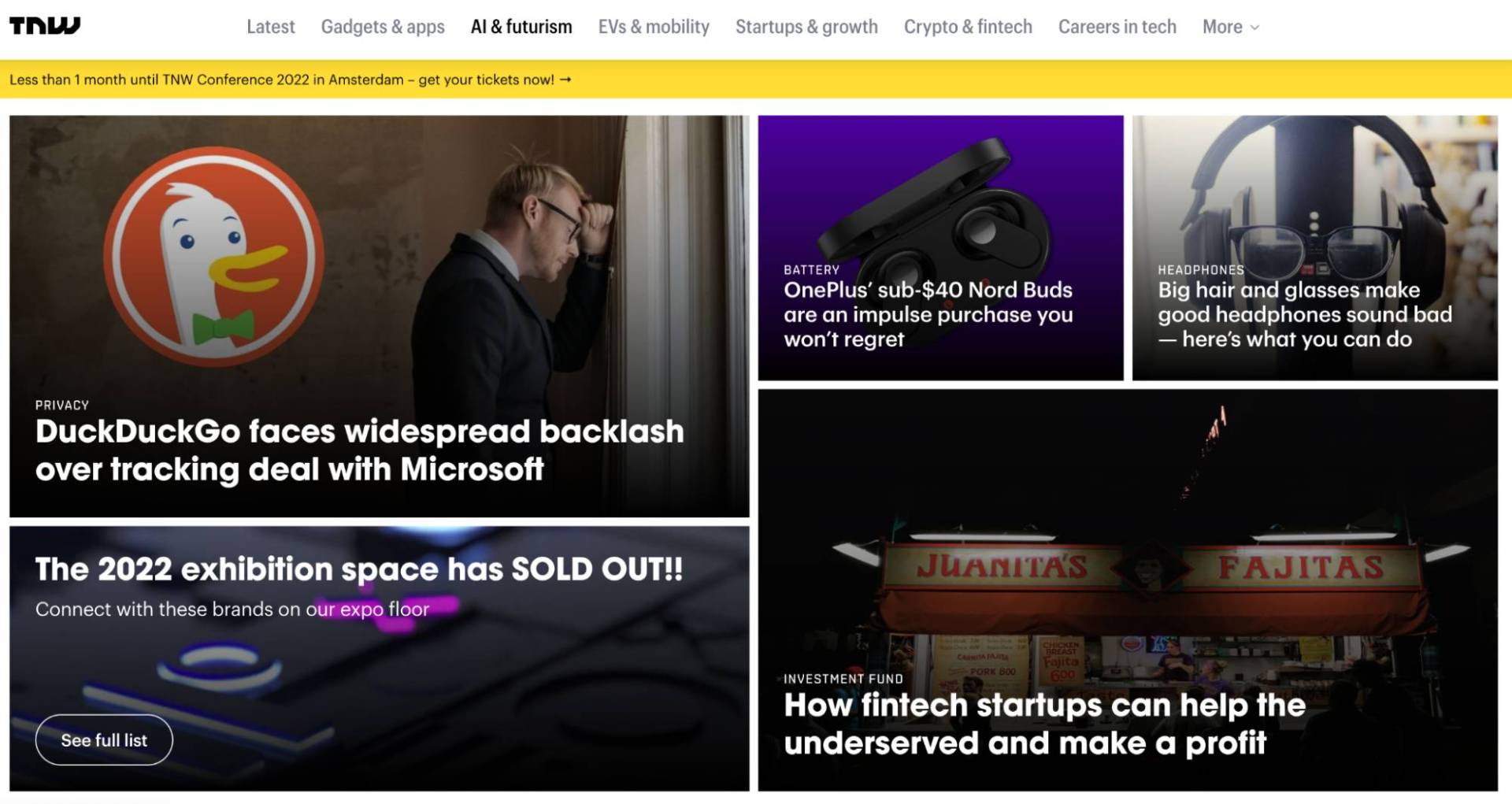
16. PC Magazine
Best source for tech product reviews
If you’re in the market for new tech gadgets, PC Mag is a great resource. They provide various reviews and how-to tutorials on the newest tech gadgets. This allows readers to come to an informed decision about the latest tech gadgets. Therefore, when you are considering investing in any new tech, we recommend checking this publication.

Looking for other publication, here are a few to pay attention too:
Great content is the foundation of effective digital PR. Without great content, online publications won’t have any reason to use you as a source or link back to your site.
And it’s not just any content that you need for digital PR. Content that compiles data from original research and presents it in an easily understandable format seems to be more effective for digital PR efforts.
Publications don’t want to link to your site if your blog is full of promotional articles about your brand. But they do want to source you if you have helpful, informative content and data that further their story.
Not only is data-driven content more likely to attract links naturally, but sites are more likely to accept your stories if they are rooted in the unique source content. These ideas will help you determine ways to gather unique, data-driven source content for your digital PR.
1. Utilize data you already have
Using your own data is the best way to ensure that your content is unique and stands out. Presenting your own data shows initiative, provides your audience with content they can’t find anywhere else and immediately elevates your authority. Most companies have more owned data than they realize, but don’t realize the potential that data holds for them.
If you or your client has a website, then you already have data to utilize. Every website gathers data, whether it’s how a customer moves through the site or what customers are purchasing. This information is great for gaining insight into customer behavior and purchase trends. Anything from customer numbers to data specific to your products or services can be used to craft compelling content.
Utilizing the analytical tools that track your own website and marketing efforts can give you insights to use in your content marketing strategy. Google Analytics is a good stepping stone, as you can look into different consumer demographics such as age, gender, and location of customers, along with the industries they work in, what they buy, what devices they use, and more.
Data you already have can move past website data as well. Does your company do any yearly reports about industry data and trends? These can be great sources of information internally, that may have the potential to be posted to your site. Use them as source content data for your digital pr and you may see that publications seek out your company for larger, industry-wide trends to the source.
2. Survey customers
In some cases, it’s better to conduct your own research through surveys, rather than using readily available data. Conducting surveys is a great way to gather information and statistics around topics you specifically want to focus on. The key to getting the best data from a survey is to know exactly what you want out of it.
Customer surveys and user-sourced data are powerful ways to highlight what your product or service can share with others. Think carefully about the questions before asking them. You want to get the best results possible to generate a variety of angles to use in your content.
You’ll want to have some questions about your company specifically, but don’t be afraid to broaden your reach and ask some industry-wide questions. The broad survey data is often what publications would want to source in their content.
Before you begin, it’s important to think about what size sample base you need to make your research credible. You’ll want a sample size large enough to know that you can glean useful data from it.
How to survey customers
- Social media: Social is a great way to use the audience you have to get information. You could post a survey to your page and ask your audience to answer some high-level questions. You could also boost your survey and get insights from a new audience.
- Email surveys: You can send out an email survey to your existing customers. You can use a variety of online tools to conduct the survey. When you get your responses, you’ll have a unique view into exactly what your current customers think about you and your industry. That can help you iterate and optimize how you work with them.
And if you want to move past just your customers, you could even survey any email list you have of leads. That may be people subscribed to your newsletter, or who have reached out to you before.
Not only do you get helpful data through these surveys. The advantage of building and implementing your own surveys is that the promotion for it through social media or email marketing creates brand awareness in itself.
3. Compile other research
Aside from your own data, there are always plenty of data sources you can use and combine to make a whole new set of data. There’s nothing wrong with using existing data, but you can use it in a slightly different way.
You may be able to get the information you need so you can create data-driven linkable content that publications will want to source. You could analyze someone else’s data and approach it from new angles that haven’t been used yet.
If you’re unsure of where to start, some targeted google searching can help you find useful data. Social media is another outlet for information. Scour hashtags that relate to what you need and see if you can find the information you’re looking for.
If you don’t have the budget to conduct your own research or the data you already have isn’t sufficient enough, readily available data could be your answer.
Focus on Your Source Content Data for Digital PR
By considering these methods, you’ll be prepared to create content that attracts and engages your target audience. With high-quality content, you will start to get the attention of online publications that want to source you in their articles.
If you do your research correctly, it will result in powerful data-driven content that will boost your digital PR efforts.
When it comes to marketing online, content is everything. But we all know it's hard to consistently post relevant content. However, it's necessary as strong content will set your company apart from competitors and increase your digital PR outreach.
Most publications are interested in citing educational, helpful information that adds to a conversation. If you’re only focused on putting out promotional content about your brand, it’s highly unlikely a publication will want to source that content.
Instead, try creating content that is educational, informative, and provides true value to relevant conversations. When you have a variety of content on your site that does just that, that’s when you’ll see success with digital pr outreach efforts. That’s when a publication will want to use your blog post full of useful data points in their article.
To get to that point, you need to be thinking through different types of source content that you can put on your site to help aid your digital PR outreach efforts. Here are some types of content to get you started:
1. Data-Focused Research
Original research is difficult for everybody. But with some hard work, it's possible, and if you do it well it can lead to incredible results. Utilizing your own data ensures that your content is unique and stands out among others.
Creating content focused on your own data shows resourcefulness and elevates your authority since your audience can’t find it anywhere else. Think through what information you can gather from your own customers, employees, or audience that would provide value to your industry as a whole. Use that as a starting point to creating data-focused content for your site.
2. Blogs
Detailed, relevant content can drive organic traffic to your website, while also informing consumers about your products, brand, and expertise in the field. Blogs are great opportunities for keyword optimization and gaining inbound links, which help with SEO and traffic growth.
More than that though, blogs are the windows to your company’s soul. They explain what you do, who you are, and why you do what you do. When you write strategically and educationally about your company, this encourages publications to utilize that information.
Make sure you sprinkle in helpful stats and quotes when applicable to make your digital PR outreach as strong as possible. Incorporating quotes around industry trends and high-level ideas for the industry within your blogs makes for the great source content. Quoting industry experts will boost the credibility of your content and overall brand. These quotes add weight to your content and what you’ve said seems more valid. That also means you're ready if publications want to use you as a source.
3. Unique Insights
Unique insights are distinctive aspects of your company that make you stand out from your competitors. It can also be a unique way of thinking you have about your industry as a whole. Using this as content inspiration is great because publications can utilize you as examples in their content.
In a world of competition, personalization has become a necessity for brands. Targeted and personalized insights help communicate a clearer message and attract customers. Unique insights can help businesses determine why people buy certain products over others and what’s driving those preferences.
4. Podcasts and Videos
The ease of use and accessibility of these digital mediums over the past several years has made them must-use forms of content. Podcasts and videos have become increasingly popular because they can be consumed somewhat passively.
Videos are more likely to hold the audience’s attention as opposed to something they have to read. Podcasts are also an engaging, personable method to reach users and allow them to easily access the content.
Both of these are great sources of content for publications to use and link to. As with all other content, make sure your videos or podcasts are moving the conversation forward and are answering questions about your industry.
5. Infographics
Infographics are great because they’re easily shareable and consumable. Creating interesting visual representations of information and statistics makes it easier to read than a list of numbers and facts.
Because these tend to have a lot of stats and numbers associated with them, they make great pieces of content to source in external articles. Think through stats that are relevant not only to your business but your industry as a whole to capture the attention of online publications. This will help make your digital PR outreach more successful.
6. Social Media Posts
Every business should be utilizing social media in some capacity. However, using social media platforms as content distribution isn’t enough anymore. You should also be creating content that’s specific to your various channels and promotes your business’s personal growth.
Social media can also be a great tool for distributing key stats, facts, and quotes about your business and industry. Many online publications will look to social for helpful snippets, so think about keeping your LinkedIn, Twitter, and Facebook up to date. Posting to social media could help provide a publication with the information they need to include you in an article.
7. Case Studies
Case studies take time and energy to create, but they also hold a substantial amount of weight with consumers. These studies are essentially success stories that show the power of your business and its services.
By researching and taking an in-depth look at specific subjects, your business can quickly increase its trustworthiness and expertise in the eyes of consumers. The more specific results you can showcase and the deeper you can dive, the more potential people will believe your company has.
These case studies can be another source of information for publications to pull if you’re sure to fill them with helpful information. When doing digital PR outreach, they can be a great tool to prove why your company should be mentioned.
Excelling at Digital PR Outreach
Strong content has and always will be the foundation of a successful marketing strategy.
But it can do more than just help to encourage readers to become customers. It can be the key to excelling in digital PR outreach. With strong source content, publications won’t have a choice but to include you in the articles they are writing about your industry.
You can’t go out and spend your marketing budget on ordering a box of credibility or a carton of trust. It would be great and incredibly easy if you could, but unfortunately both of those things have to be earned.
Equally, you can’t just tell people that you’re a great, trustworthy company, with an excellent product, and amazing customer service. Well, you can, but it’s far more effective when it comes from someone who has nothing to do with your company. And that’s where linkable content and earned media come in.
What is Earned Media?
Earned media is content written about your business by other people and published on platforms that you don’t own. For example, a well-respected review site in your niche might write a great review of your new product or service. Or a site could quote your CEO in one of their articles and link back to a case study or some research you did.
This isn’t achieved by buying an ad or paying someone to post your guest blog on their site. It’s, as the name suggests, earned by being good enough to deserve a mention or a backlink.
While you could send a press release for something that’s genuinely newsworthy, you could get mentioned simply for having valuable content to share. If you have industry insights, in-depth research, or information on what’s trending, you have something that could appeal to a wide audience. And that means that a site may mention you organically as a source for an article.
Publications are always looking for good content that’s valuable to their members. If you want to appear in Forbes or the latest issue of your trade magazine, think about what you need to put on your website that will be something they want to link to and source.
How Linkable Content Helps Earn Media Mentions
Getting publications to mention you and link back to your site is no easy task. There are a couple of different ways to do it. You can spend hours doing personalized outreach to every online publication you can find. That’s thousands of emails to editors, contributors, or whatever other email you can grab from a site.
However, the other way to build your digital PR strategy and get those earned media placements is to have them come to you. And that’s through that linkable content.
Linkable content has been specifically crafted to attract attention and entice high domain authority sites and publications to link to it. Again, it has to be good enough; data-driven, and full of unique insights and quotes.
While you might wish that the top publication in your niche would link to your sales page, that’s highly unlikely. However, if you write an article that’s impactful and full of value, you will gain domain authority. Your content is also more likely to be used and shared.
Types of Linkable Content
Getting those earned media mentions is invaluable for your company. However, you can’t get that third-party validation without having the right type of content. As we mentioned above, linkable content can come in many forms:
- Data-driven content: This is content that is focused on providing industry data and insights that goes past information about your business alone.
- Quotes: Include quotes for your c-suite that hit on industry-wide trends.
- Unique company findings: Post content about the unique ways your company operates, or unique industry information your company has discovered.
- Podcasts or videos: Linkable content isn’t just for your blog. Post regular podcasts about your industry and informative videos about it as well to stay relevant and educational.
The types of linkable content doesn’t end there. Make sure you’re exploring all the different ways you can provide great content that online publications will want to source to and link to in their own articles.
And creating linkable content isn’t a one-and-done situation. It should be an ongoing effort so your company is providing fresh, valuable insights on the regular.
Why You Need Earned Media for your Digital PR Strategy
Earned media can be an important part of your overall content strategy and your digital PR.
What makes it so important?
From Nielsen's Trust in Advertising study, “88% of global respondents trust recommendations from people they know more than any other channel. What’s more, 50% more people trust recommendations than lesser-ranked channels like online banner ads, mobile ads, SMS messages, and SEO ads.”
Consumers are increasingly internet savvy. They know that what you say about yourself is designed to promote your products or services. Of course, you still need your own promotional content, but it does mean that consumers may take it with a pinch of salt.
When another site picks up your content, however, consumers know that they don’t have to do that. Other sites don’t have any reason to mention your content or your business unless they think what you have is valuable enough. Consumers will see this content as unbiased, third-party validation and take it more seriously than anything you post yourself.
When other sites and publications publish your content or link to it, of course, you get all-important backlinks to boost your rankings. You also get a whole host of other benefits, including brand credibility and awareness, and increased trust in your products and services. You can reach wider audiences with this strategy and build your authority and credibility.
And being mentioned in online publications is only one part of beginning to truly own your industry. If you want to eventually be the name that people think of when they think about your particular industry, you’ll need a strong mixture of digital PR, SEO, and onsite content.
Dive Into High-Quality Content
All you can control is what you do and how much effort you put into it. Create high-quality, linkable content that’s targeted and full of value and it's more likely that your content will be shared.
With a consistent approach, you can build a strategy that brings you the earned media you deserve.
The importance of making sure you select the right digital marketing tools can hardly be overstated. While there's nothing that beats a powerful marketing strategy and a top-notch creative team, choosing the best technology stack for your business can make a huge difference when building an online presence.
The market is chock-full of digital marketing tools, whether they be for analytics, email marketing, or website engagement. But don't let that intimidate you. Here are 10 leading marketing and automation tools to help you with your daily tasks while also giving your site a competitive edge.
Whether you work in a B2B or B2C domain, using the right tools can help you understand and reach your target audience more effectively. With these in your arsenal, there's little doubt you'll take your future online campaigns to the next level.
1. Google Analytics
As a digital marketer, you've almost certainly heard of — and used — Google Analytics. It's the top free tool in use and one of the most effective digital marketing tools available to help you track customer demographics, understand traffic, and keep an eye on keywords. It also provides insight into everything from the customer's gender to their location.
With Google Analytics in your arsenal, you can easily discover the affiliate site or exact hashtag that drives most of the traffic to your website. All this data can then be used to optimize site performance and help you develop better marketing campaigns.
2. Agorapulse
Agorapulse is an all-in-one digital marketing tool for your social media marketing needs. With its foolproof PR and social media management features, it can help transform your outreach and audience interactions.
Its numerous features include planning and scheduling posts, checking analytics reports, and maintaining engagement. Agorapulse also enables you to build a unified inbox, connecting your messages and comments from all your social media handles onto one platform.
With such powerful features in addition to being a great value, Agorapulse ranks No. 1 as a social media management tool on Capterra and TrustRadius.
3. HubSpot
Another powerful tool to have as part of your marketing strategy is HubSpot. With its inbound methodology, it provides a complete solution to all of your digital business needs. In addition to letting you keep an eye on content ROI reporting, you can also set up live chatbots and direct leads to your social media. Coupled with a decent email newsletter service, you're all set.
HubSpot is a customer relationship management (CRM) software that consists of everything from marketing and sales hubs to customer service and operations — all in one package.
4. Piktochart
Don't have a graphic designer on your team? No problem! Piktochart is a powerful tool that will help you design aesthetically pleasing visuals for your brand in no time.
Piktochart is a digital marketing tool that allows you to design infographics, videos, presentations, and much more based on a range of available (and customizable) images, icons, and fonts. All you need at that point is a logo maker tool to develop your logo. You can then paste it on any of the graphics you use for your digital marketing campaigns. With its drag-and-drop features and user-friendly interface, Piktochart is extremely easy to use and a must-have tool in your arsenal.
5. Trello
As a digital marketer, you're probably working on a dozen projects at the same time. Make your life easier by using Trello, one of the most intuitive organizational tools out there.
You can make a "board" for your team and use "cards" to track the progress of different projects simultaneously. Each team member can provide feedback and manage changes before publishing the content. This flexibility allows you to easily collaborate with your team members and keep your marketing strategies organized in one place.
6. Slack
Slack offers an efficient way to communicate with your team quickly and bring focus to all of your projects on one platform.
It consists of channels each of which can be customized according to the task you're working on. Whether your marketing team wants to brainstorm or implement an idea, everyone can use the channel to collaborate and pitch in ideas in the form of files, images, or videos. Apart from building teamwork, Slack also has incredible features to help you tackle various marketing integrations.
7. BiQ
If you're not an expert in SEO yet, BiQ is a must-have for your tool chest. From keyword and content intelligence to rank intelligence and tracking, it's an all-in-one solution to your SEO needs.
With this digital marketing tool's unique features, you can look out for profitable keywords, track your ranking progress, produce high-quality content, and boost your visibility. With BiQ, you can get total control over your website's SEO and a great value for the money.
8. Ahrefs
Ahrefs is another digital marketing tool known for its SEO tools. It allows you to track your site's rankings, compare it with competitor websites, analyze backlinks and top-performing content, look out for keywords, and much more.
With this powerful tool, you can obtain highly advanced marketing metrics and get the top ranks on search engines. Whether you're a beginner or an expert in digital marketing, Ahrefs will assist you with everything related to SEO you're likely to need.
9. Lucky Orange
Lucky Orange delivers dynamic heat maps for your site which help optimize traffic and conversion rates. It records a website visitor's every move, detailing each movement such as how long they interact with the site, where they click, and so forth.
By identifying areas that need improvement, you can develop a user interface that will prove rewarding in the long run. Moreover, you can even use this unique tool to subscribe to daily/weekly reports of the traffic performance on your website.
10. Brand24
Another key marketing tool is Brand24, which makes use of artificial intelligence to manage your online reputation and maintain your brand image.
The tool offers useful insights into what your customers think about your brand and how they perceive it. Based on keywords, it monitors all instances of your brand mentions in blogs, podcasts, news, and more. It also filters out the positive and negative mentions. The next time a customer posts a bad review, you can respond to it before it becomes viral.
The Best Digital Marketing Tools Enhance Positive Messaging
Prospering in the digital marketing landscape is all about mastering the right kind of tools. You can choose to invest in SEO applications and content development or personalization software and chatbot platforms.
While it's essential you add these to your toolbox, it's even more important to pick the right tools according to the specific needs of your brand. Test out different platforms. Employ them in your marketing strategies. Discover for yourself which ones can successfully establish your brand in the industry.
Being on video can be scary.
I won't sugarcoat it. We've all seen the data. People fear public speaking more than death. Combine public speaking with all the new considerations and pressures of presenting in virtual environments — from adjusting microphones, lighting, and camera framing to selecting the perfect virtual background — and it’s not surprising that people feel overwhelmed or uneasy about presenting on video.
Many of us will be transitioning back into our offices in the coming months. Many of our new work setups will be a hybrid of in-office and remote team members on any given day. Because there may always be someone who isn't in the office, video meetings and virtual presentations will play a key role in the hybrid workplace. They will help ensure that we are treating our remote colleagues equally and conducting live meetings in the most efficient way.
The good news? There are a few simple steps you can follow to ensure that you're feeling confident on video and creating engaging virtual presentations. Following these tips can help you stand out in front of coworkers, clients, and customers in your new hybrid office setup.
Virtual Presentations Can Be Powerful Career Boosters
Knowing how to present yourself and your message over video is going to prove critical to your success.
Check out my story below for how I got my start on video, nerves and all. This year, I made it my mission to do even more public speaking and virtual presentations. Practice makes perfect, after all. I’ve been able to draw on my experiences at amazing companies such as LinkedIn and Prezi to help others become more confident on video. I like to help them create truly engaging virtual presentations that wow their audiences.
Below are the most useful tips I've learned on my journey so far.
How to Appear More Confident on Video
1. Use visuals.
Before the pandemic, it was already difficult to capture someone's attention. During the pandemic, it became that much harder as our screens became our main source of connection to everything and everyone.
Screen sharing became the status quo but it wasn’t an effective way to engage people over video. It became evident early on that audiences began to tune speakers out when they switched the video call screen away from their face to display other content.
So how do we break free from the status quo? One of the best ways you can do this is by bringing visuals into your presentation and saying goodbye to screen share.
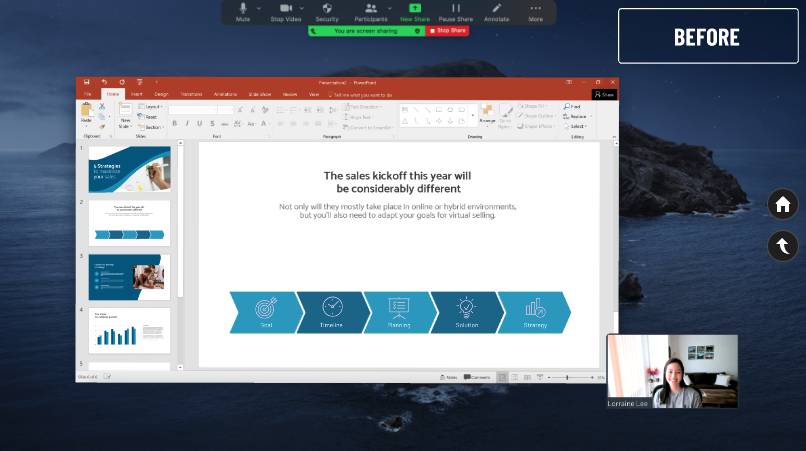
From Prezi research, we've learned that when someone is looking at the screen, they're most engaged when there is visual content being shown in the same video feed as the presenter. You need to see the facial gestures and expressions of the presenter combined with visual content to create a compelling presentation. Screen sharing gives us one without the other, and that's where standard presentations have fallen short.
There are plenty of stats out there, but the one that surprised me the most was that 90% of the information processed by the brain is visual. If you're using visuals well, you're going to have a more impactful presentation, which in turn will drive audience engagement.
Have you ever told a story and had your audience hanging on your every word, excited to see what comes next? That same positive feeling and confidence boost can apply to your presentations. Give them a great show and they'll want more.
The image below is using the same content from the screen share above. However, it's a lot more enticing to look at than the "Before" screenshot above.
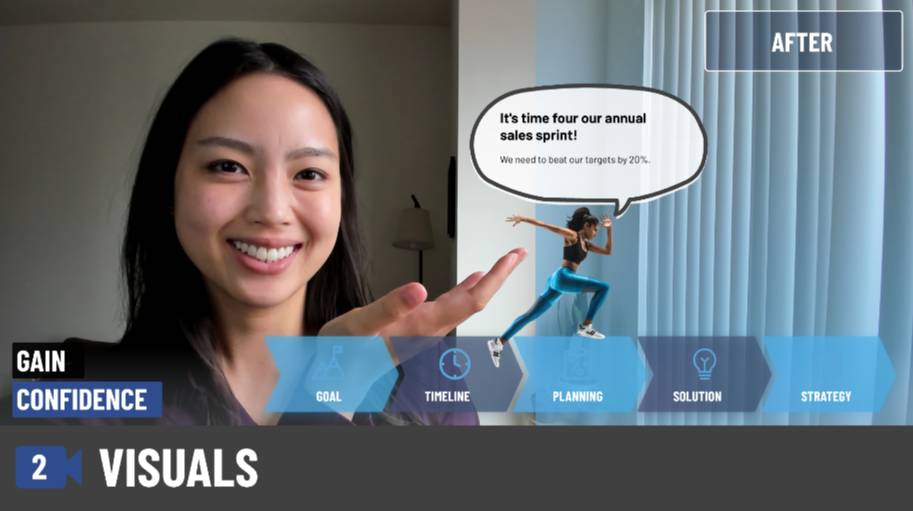
Another way that I've found visuals give me confidence is that they help balance out the audience's focus between me and my content.
Probably one of the most intimidating things about presenting is realizing that everyone's eyes are focused on you. That said, when you are using visuals well, their eyes should be moving back and forth. This also keeps them more engaged.
For the non-designers out there, don't worry about building something from scratch. You can use templates offered by tools like Prezi Video, Google Slides, Lucid, and others. Additional resources like Remove.bg and Creatopy will do wonders if you don't have Photoshop.
Be sure to check out this video by career coach Diana Chan. She uses a template and simply adds her text and images as she would in PowerPoint or a similar program.
2. Add lighting.
Lighting is another crucial element for building confidence.
Although it may not seem obvious at first, lighting has a psychological effect on you as the presenter. When you add lighting to a presentation, it makes your video and you look better, more professional, and more credible as a speaker. And if you and your video look great, you're going to feel better about how you're coming across sharing your ideas. This leads to more confidence.
It's best to have your light source aimed toward your face to avoid a dark screen from a backlight effect. Ideally, you should face a window to ensure that you're receiving natural light. If you still need an extra boost, a good ring light ranges from $20-$35. These can make a huge difference in your virtual presentation. I personally have two flanking my desk.
3. Set up your space.
Another thing you'll want to do to build your confidence is to record in a proper setup. Go for a non-cluttered background for your virtual presentation. Similar to lighting, by appearing more professional, you will feel more confident with the impression you're leaving on the audience.
Most of us don't have the luxury of having a home office that's straight out of a West Elm catalog, and that's okay. I recommend hacking your space. Buy a room divider or hang up a curtain to create a distinct workspace. A non-cluttered background will help you feel more confident about how you and your content appear on camera.
Of course, as you get more comfortable, there's certainly room to get creative. Try stepping outdoors to get that natural lighting I mentioned earlier. Consider adding personal touches to your background. These can offer insight into who you are without being too distracting to the audience.
Virtual Presentation Skills Are a Worthwhile Investment
As the current trend in influencer marketing demonstrates, it's clear that video is here to stay. If you're still feeling overwhelmed or unsure, take it step by step. This isn't something you'll master overnight. However, with practice and time, I’m confident you will improve and impress whoever is on the other side of the video call.
Marketing moves fast. While trying to rock this year’s campaigns, you have to think about what next year’s should look like.
What will 2020 be all about? In a phrase, media relations. Given that 46% of Americans don’t trust the press, 2020 will be a time for you to re-evaluate your media relations and make sure you’re being strategic with your efforts.
Expect these trends to take center stage in brand-media relationships in 2020:
1. Trust Will Dominate
Consumers are demanding more out of brands than ever before. Brands no longer just need to provide a great product, but also need to create an emotional connection with their consumers. But how do you build that connection in 2020, when consumers have endless choices online? One way is to foster trust. In fact, 66% of consumers say they feel connected with a brand when they trust it.
“Trust has never been more important for companies to focus on with their customers. Getting consistent articles mentioned in media helps you stay Top of Mind in your industry so that when a customer needs something they think of you" said John Hall, co-founder of Calendar and a top motivational speaker.
2. Helpfulness Will Be How Brands Win
When you start getting those third-party mentions, make sure you’re focused on helpful, informative content rather than pushing for promotional features. With 131% of consumers more likely to buy after reading educational content, you can’t expect to succeed in 2020 by being anything other than helpful.
Think about what problems your audience is trying to solve, and what areas you have expertise in. Mentions that touch on those problems and your knowledge around their solutions will help set your content apart from competitors.
[insert page='here-are-the-latest-content-marketing-trends-for-2020-you-cant-ignore' display='single-related-article-02.php']
3. Media Mentions Will Be Driven by Data

Data has always played a role in marketing, but it’s becoming particularly important for media relations. Companies are looking for more knowledge around how their media efforts are performing and who their content is reaching. In fact, 40% of marketers say they struggle with proving the ROI of their marketing activities, including media mentions.
The problem, though, isn’t a lack of tools. “The tech is already there,” explained Erik Huberman, outsourced CMO agency Hawke Media. “Now, it’s a matter of executing.” Marketers will need to cross-reference social listening, CRM, and audience data to discover which audience groups are seeing and responding to their media mentions.
4. Keywords Will Shape Content Strategies

Because 93% of online experiences begin with a search, you need to make sure your content is showing up in those searches. It’s no longer enough to merely get media attention. You need to know what your audience is looking for and ensure you’re hitting those keywords in your mentions so your content surfaces.
Brands will be doing deep dives into what keywords are driving traffic to their site, and they’ll be targeting mentions around those ideas and themes. Send out surveys. Better yet, convene a focus group. The more you know about what topics your audience is interested in, the better you can capture their attention when they’re looking for help.
[insert page='step-by-step-guide-to-keyword-research' display='single-related-article.php']
5. Micro-Touchpoints Will Become Key
Sure, your 1890-word blog is important. But what’s more important is making sure your audience sees a snippet of that blog when they happen to be looking for a solution to their problem. Stats show that 49% of people will stop reading a message after 111 words. With attention spans at an all-time low, micro-touchpoints at exactly the right time will be more important than ever in 2020.
Mentions of your company follow the same rules. A full article featuring solely your company will always be seen as incredible. Pair it with smaller mentions of your company in other publications to get the most bang for your buck. A paragraph here and there that a customer sees when they’re searching for a solution or looking into your industry is a valuable way to give your company a greater presence with your audience.
The new year will be here before you know it, and it’s never too early to prepare for your 2020 marketing efforts. It’s time to start planning how your company is going to engage with external media to build trust and credibility with your audience.

